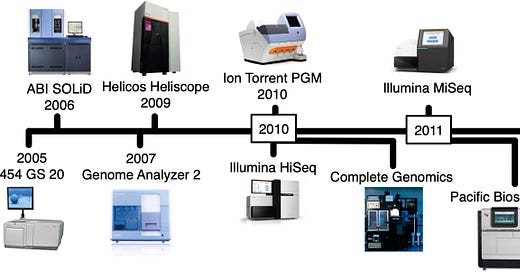A Look At Ion Torrent (and some chips)
I’ve been looking at a few Ion Torrent chips. Ion Torrent hasn’t been a massive commercial success, but the Ion Torrent PGM was an important instrument for a number of reasons. So let’s talk about Ion Torrent!
(if you just want to see chip pictures, scroll to the end).
First let’s take Ion Torrent in context. The Ion Torrent PGM was Ion Torrent’s first DNA sequencer. When it was released (2011) the “next-gen” DNA sequencing market was firmly established. BGI had already purchased 128 ~$600K Illumina instruments and we were well into the 1000 Genome Project.
They therefore entered a market with solid competition from Illumina who already likely had ~90% market share. Illumina’s instruments were producing 200Gb of data, in contrast Ion Torrent chips produced only 600Mb at lower quality. Requiring a large disposable semiconductor die, the Ion Torrent COGs was also probably significantly higher than Illumina.
Ion Torrent therefore could only really play on capital costs, releasing a instrument far cheaper than anything offered by Illumina (~$80K versus ~$300K for an Illumina Genome Analyzer 2).
Unfortunately, Illumina released the Miseq around a year later for $125K, Illumina sample prep was easier, data quality and throughput higher. This allowed Illumina to continue to dominate in the low-end market too.
So why was Ion Torrent important? Two reasons:
It was probably an amazing exit for investors. Ion Torrent was acquired by Life technologies only 3 years after it was founded, meaning there was likely minimal dilution. A good exit for investors likely fueled further interest in funding novel DNA sequencing platforms.
It pushed Illumina to release the Miseq.
At the time Illumina had just released the Hiseq increasing the initial investment required to get started in sequencing. It seems likely that they would have continued to push customers toward larger more expensive instruments if Ion Torrent hadn’t forced them to release the Miseq.
The Miseq remains Illumina’s most successful instrument, but one they haven’t updated in 11 years, the reasons for which I’ve discussed elsewhere.
Ion Torrent Chips
So that’s Ion Torrent, a instrument which certainly shifted the market but gained limited market share. Now let’s have a look at some chips!
The Ion314 and Ion318 chips were released for the original instrument, the PGM in 2010. The PI and PQ chips are for the instrument (Ion Proton) released after acquisition of Ion Torrent by Life Technologies (now Thermo). There are newer chips, but I’m afraid they’ve not appeared on eBay yet.
The Ion Torrent sequencing approach uses ISFETs. These are pH sensor arrays (millions of sensors). Each sensor sits under a well on the chip, as the DNA incorporates nucleotides it causes a pH change which can be detected. You can read about the full process elsewhere.
A few things are immediately obvious looking at these chips. The original chips (314, 318) have an eye-like fluidic structure where the sequencing reagents flow. You can see this on the iSeq too. Why not a rectangle which would maximize use of the die? Probably because fluid wouldn’t flow into the corners as easily. Reagents could therefore diffuse into the corners and would not be completely washed out between cycles. This would cause reagent mixing, introducing noise and other signal artifacts.
Subsequent chips seem to have somewhat addressed these and moved to a rounded rectangle.
At the chip level too we can see differences too:
Most significantly, feature size has been steadily decreasing, from ~3 micron wells on the original chips to <0.7 micron in current chips. This seems to approximately match the references I could find. The best I could find on recent Ion Torrent chips is that “sub-micron” wells are used. It’s interesting to think that these wells and density might become sub-diffraction limited (perhaps unlikely, but interesting).
These features appear to be smaller than those used on the iSeq. They’re also much smaller than the feature sizes used on the MinION.
Overall, I’m left impressed by the technology which seems to have found its niche, but it unlikely to gain popularity, particularly in the face of increasing competition.
I’ll likely be looking more at the Ion Torrent PGM in the future. If this interests you, consider subscribing!





